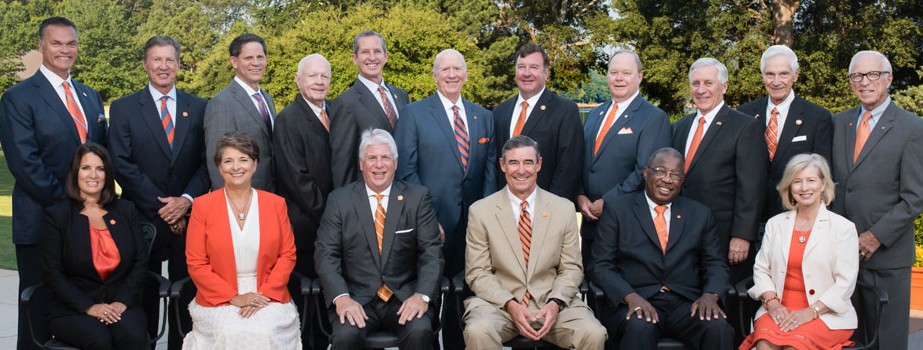
By Lindsay Street, Statehouse correspondent | You almost need a fine-toothed comb to find anyone other than a white man on public university governing boards in South Carolina.
This conclusion comes from a new Statehouse Report review of South Carolina’s public universities. It found governing board members are 75.8 percent male and 84.5 percent white — and zero members were of Latino, Asian or Native American ethnicity.
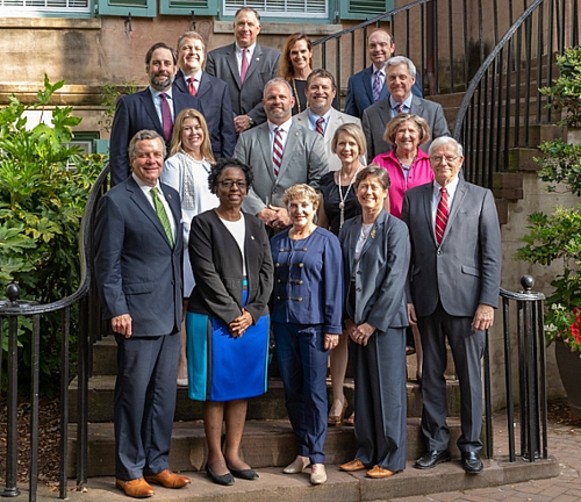
Having boards that are more than white and male are important, Senate Education chair Greg Hembree, R-Horry, told Statehouse Report.
“You want to get diversity and experience and perspective,” he said. “First and foremost, you want the best people to do the job. However, on the second part of that, women have a different perspective then men many times, and people of different races have different perspectives.”
Of South Carolina’s 161 public university board members, including ex-officio members, 39 were female and 25 were black. The review was pulled from a public data request made to the institutions as well as a review of university websites. Half of state universities complied with the request, with the other half leaving it up to the publication to infer race and gender for trustees.
The University of South Carolina, which has a controversial board meeting today purportedly to pick a new president, has a governing board that is 88.9 percent male and 94.1 percent white. It did not directly respond to the request for information, citing today’s vote.
USC has the lowest percentage of women serving (tied with S.C. State University at 11.1 percent) and the second lowest percentage of African Americans (5.9 percent) serving on its board.
In an opinion piece published Thursday in Inside Higher Education, USC alumnus and My Carolina Veterans Alumni Council founder James L. Anderson bemoaned the lack of diversity on his alma mater’s governing board and among S.C. higher education institutions’ trustees:
“The makeup of public boards for universities and colleges is heavily skewed toward white, male baby boomers.”
Winthrop leads in board diversity
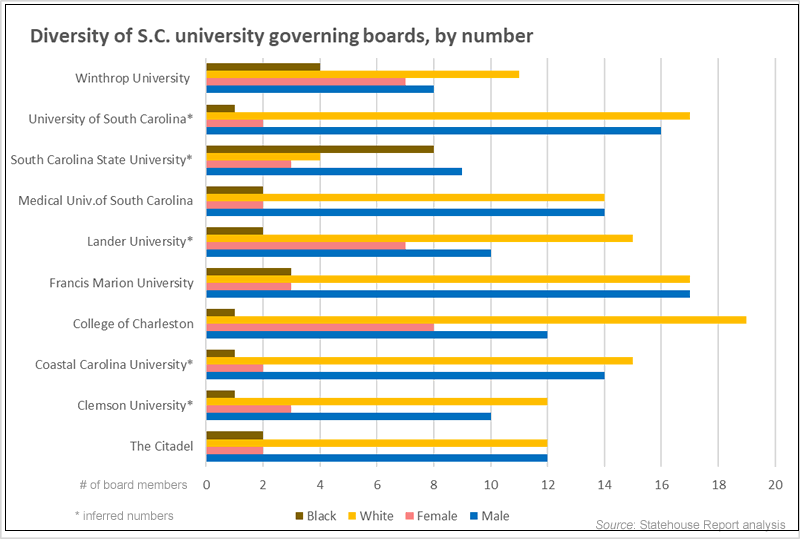 The state’s only public historically black college, S.C. State University, had the highest rate of black trustees at 67 percent, but also the lowest rate of women serving on the board (11.1 percent), according to our analysis
The state’s only public historically black college, S.C. State University, had the highest rate of black trustees at 67 percent, but also the lowest rate of women serving on the board (11.1 percent), according to our analysis
On the other hand, College of Charleston had one of the highest rates of women trustees (40 percent; only Winthrop and Lander universities were higher at 46.7 percent and 41.2 percent respectively), but had the lowest rate of black trustees at 5 percent.
More findings:
- Winthrop University had the second highest percentage of black trustees at 26.7 percent.
- Coastal Carolina University had the third lowest rate of black members serving (6.25 percent) and also the second lowest rate of women serving (12.5 percent).
- At the Medical University of South Carolina, women made up 12.5 percent of the board, and African Americans made up 12.5 percent of the board. At The Citadel, where its members must be alumni and it began accepting women since 1996, two of its 14-member board are women, accounting for 14.3 percent of members.
What’s being done
Governing boards in South Carolina public higher education vary in size from 12 to 20. While most trustees are elected by the General Assembly, the governor and alumni also make appointments. Some members are tied to congressional districts or, in the case of University of South Carolina, are tied to the state’s 16 judicial circuits.
Senate President Harvey Peeler, R-Cherokee, is chairman of the College and University Trustee Screening Commission, which reviews legislative-appointed candidates to the board. He did not respond to a Thursday request to comment.
The overwhelming majority of members of the General Assembly also are white and male.
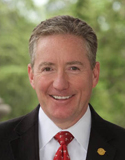
Hembree is familiar with the university board election process, but does not oversee or take part in the screenings before the chambers vote on candidates. He said the commission only screens for qualifications. He said boards could encourage diversity through a governance committee, which would encourage qualified and diverse candidates to apply for seats.
“They would be in a position to say we have three lawyers on this board right now for goodness sake don’t send us another lawyer but we need an architect … whatever it might be,” Hembree said. “It’s not radical. It’s kind of smart and it’s very common in the private sector.”
Hembree said he was unaware of a governance committee for any public college in the state. The state Commission on Higher Education was also unable to provide that information.
He said he may explore a statute that would help provide “overarching guidance or direction” for board member selection.
Anderson said governing boards should also impose term limits to help become more diverse and reflective of its student body.
“A truly cross-generational and more diverse board is necessary to meet the opportunities and complex challenges of tomorrow,” Anderson wrote. “Term limits could be a first step toward reaching that goal.”
Another USC alumni, John Warner, penned an opinion piece in the same publication, partially in response to Anderson. He called for half of the board to be selected by students and faculty rather than lawmakers — a board composition that is not evident at any public university in the state.
Others have called for boards like USC’s to have fewer members.
How we obtained the data
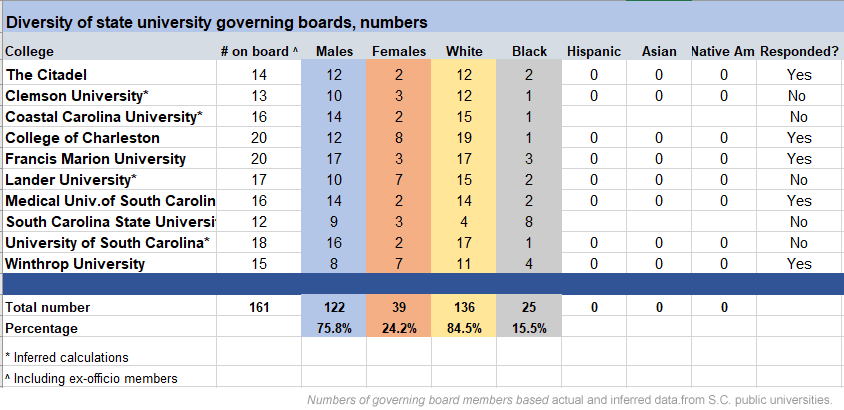
On Monday, Statehouse Report requested the information of the state’s 10 publicly-funded higher education institutions: The Citadel, Clemson University, Coastal Carolina University, College of Charleston, Francis Marion University, Lander University, Medical University of South Carolina, S.C. State University, University of South Carolina, and Winthrop University.
Five responded with the demographic information requested by deadline.
Data from the other five universities was obtained by reviewing photographs and titles available on the schools’ websites. Because these five universities would not corroborate the findings, Statehouse Report recognizes it is possible that this information is incorrect as it is difficult to accurately discern race or gender from just a picture. However in the interest of providing a fuller picture for the story, the publication chose to make inferences. If readers find any of the data incorrect, please alert the publication.
Of the five universities that did not provide information on the public officials, only S.C. State University and Clemson University did not respond at all.
University of South Carolina spokesman Jeff Stensland responded Thursday, three days after the request:
“As you may or may not be aware, we are preparing for a board meeting tomorrow, so will not be able to provide you with all the information you requested by your deadline.”
Lander University spokeswoman Megan Varner also responded Thursday:
“We’re unable to provide this demographic information at this time, as we do not collect it from our trustees.”
Coastal Carolina University Chief of Staff Travis E. Overton said the publication needed to submit a Freedom of Information Act (FOIA) request to obtain demographic information of its board. Such a public records request can take up to 14 business days, and was not required by any other public university in the state.
“I would need to defer to the FOIA Office to answer that question,” he wrote in an email. He did not respond to further requests for comment.
- Have a comment? Send to: feedback@statehousereport.com
















 We Can Do Better, South Carolina!
We Can Do Better, South Carolina!
Why not require trustee board demographics to reflect the demographic makeup percentage of their colleges and universities that they serve as long as they meet the job qualifications? Doesn’t research show that people in a position of choosing successors will lean to selecting people that are just like them? So something must happen to force the change or the current situation will continue.
Nice work Lindsay.
What do the boards of the community colleges in South Carolina look like? A discussion of higher education in the state should include the community colleges.